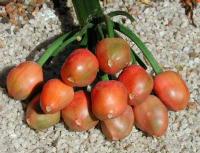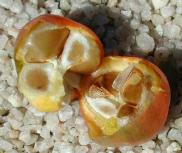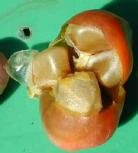 Photo 1 shows the nice and ripe berries ready to be cleaned.
Photo 1 shows the nice and ripe berries ready to be cleaned.
CliviaNet___________
for clivia lovers around the World
| CliviaNet Home |
| Clivia Overview |
| Cultivation |
| E-Mail and Chat |
| Clivia Society |
| Photo Gallery |
| Seed Exchange |
| Sources |
| Links |
After the extensive notes on pollination with the last harvest time story, I hope you all managed to open and view it. I think you are now all going to end up with masses of berries all filled with wonderful seeds, and you can't wait to plant them. Before planting though you have to perform a bit of a messy task. I think of organising a berry cleaning party and get them all done in one foul swoop.
 Photo 1 shows the nice and ripe berries ready to be cleaned.
Photo 1 shows the nice and ripe berries ready to be cleaned.
 On opening you will find the precious seeds, all those wonderful crosses, they are all covered by a very thin membrane, and you must remove this membrane, as it loves to rot and attract fungii, it may help to wash the cleaned seeds frequently as you proceed, it will help to get the jelly off, that is why I hang them for a while, then it is not so mushy.
On opening you will find the precious seeds, all those wonderful crosses, they are all covered by a very thin membrane, and you must remove this membrane, as it loves to rot and attract fungii, it may help to wash the cleaned seeds frequently as you proceed, it will help to get the jelly off, that is why I hang them for a while, then it is not so mushy.
 This little thin membrane if allowed to dry out becomes very hard and the root has difficulty emerging from the micropore, that is when you may have to help and open the radicle. Observing the way they germinate in nature, the berry stalk becomes very top heavy with the ripe berries, it topples over and the berries land on the ground, it is during our wet season, and these plump berries just rot into a jelly pulp with the seeds in this mess. I think there is some method in this as it seems an enzyme (or call it what you like) is produced that facilitates the emergence of the radicle. Just a thought.
This little thin membrane if allowed to dry out becomes very hard and the root has difficulty emerging from the micropore, that is when you may have to help and open the radicle. Observing the way they germinate in nature, the berry stalk becomes very top heavy with the ripe berries, it topples over and the berries land on the ground, it is during our wet season, and these plump berries just rot into a jelly pulp with the seeds in this mess. I think there is some method in this as it seems an enzyme (or call it what you like) is produced that facilitates the emergence of the radicle. Just a thought.
Cheers for now, Loukie